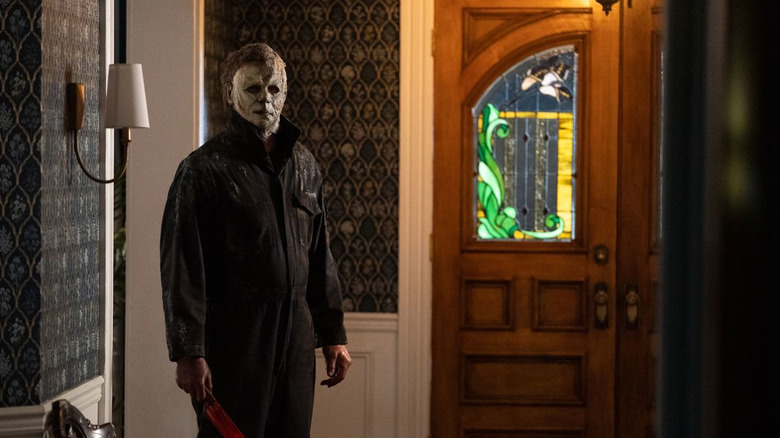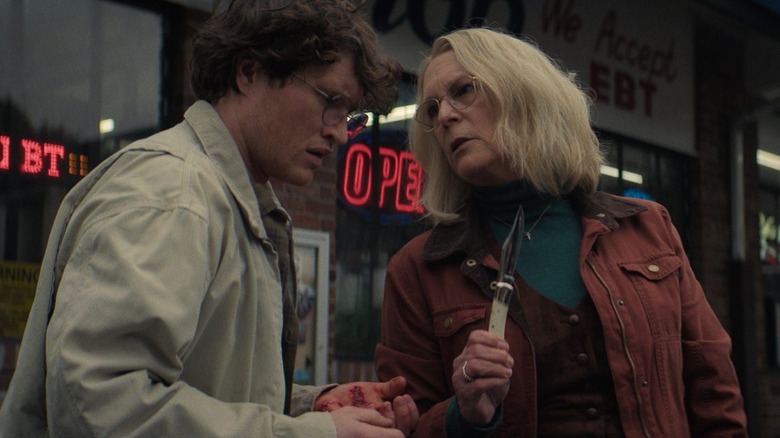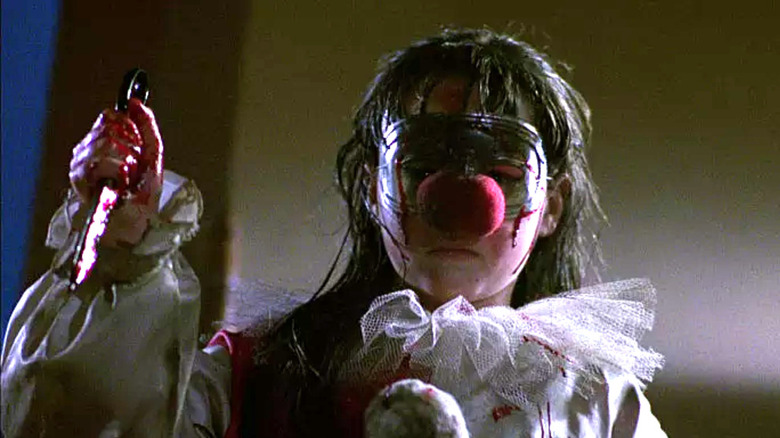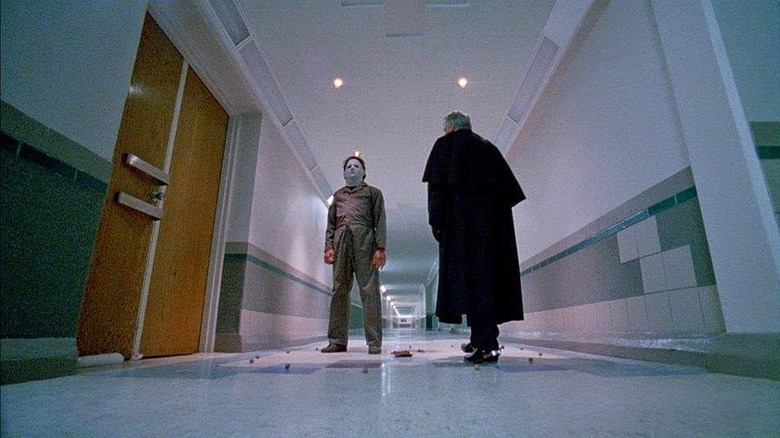Halloween Ends Is Like An Update Of The Thorn Trilogy
David Gordon Green's "Halloween Ends" caps what is known as the "H40" trilogy, breathing new life into the Michael Myers-centered "Halloween" franchise that has chugged along since John Carpenter's original horror film in 1978.
In the new trilogy, Myers — or The Shape, as he was referred to in Carpenter and Debra Hill's script for the o.g. "Halloween" — has returned to the town of Haddonfield with the same unquenchable bloodlust he's held across decades, fought Jamie Lee Curtis' Laurie Strode and the townspeople (all of this over the events of Green's "Halloween" and "Halloween Kills"), and now holes up underground to nurse his wounds. Green, along with co-writers Danny McBride, Paul Brad Logan, and Chris Bernier, brings back beloved legacy characters like Strode, who once again heads into battle with the masked psychopath who attacked her and killed her friends four decades ago. "Ends" also makes introductions to new faces like that of walking red flag Corey Cunningham (Rohan Campbell) who, after a brush with a weakened-but-deadly Michael, soon picks up the pale-faced mask and starts dropping bodies.
The "Halloween" movies have always been malleable. Warring timelines dictate that, at various times, Michael and Laurie are siblings, and that the former is controlled by magic runes. One sequel doesn't even include Myers, but offers the threat of mass ritual child murder instead. In a franchise that runs thirteen films deep, we're bound to see repeat motifs and variations on the same idea, and it turns out that the idea of a trickle-down evil influence can be seen in prior entries, with mixed results.
Killer Corey Cunningham
In Green's world, evil can be infectious. All it takes is the magic touch of a monster to get an impressionable youth to be the Gilligan to his Skipper. In "Ends," Corey is tormented, a pariah of Haddonfield years after he accidentally caused the death of a kid he was babysitting. He can't show his face at the local watering hole, lest the dead kid's mother publicly shames him. He's recognized and assaulted by the meanest band kids ever seen in a slasher movie. His mother (Joanne Baron) is an oppressive feminine force and his father is numb. It's in this state that Corey meets the Boogeyman, and he's nearly killed for it.
By the iron grip of Michael's scarred hand on his throat, Corey would be seismically and psychologically altered. A flurry of violent images erupt within him, a rapid-fire montage of pain and suffering that indicates that Michael tagged him and now he's it, "it" being the town's next threat. Not a possession — "Jason Goes To Hell" milked that concept dry — but an amplifier. Whether Myers unleashed latent darkness in Corey or whether he simply snapped after years of being the local pariah is one of the questions Green navigates in "Ends."
Michael senses something in the boy and releases him and after that, anyone who crosses Corey meets a nasty end. Corkscrews, blowtorches, wrenches, and various musical instruments are employed in various ways, all with the same goal of retribution. From the moment Michael touches him, it's not a far trip from stabbing an attacker with hesitation and shock to frantically, repeatedly plunging a corkscrew into his girlfriend's boss. This influence comes fast and furious and echoes previous strains of commutable evil in one of the franchise's most polarizing (now-discarded) timelines.
Reach Out and Touch (Somebody's Hand)
"Halloween" entries four through six are known as the "Thorn trilogy," in reference to the Druid curse that a cult uses to control Myers (yes, really). These films continue on the thread established in 1981, connecting Michael to Laurie via a sibling connection.
Coming in a decade after John Carpenter's original, "Halloween 4: The Return of Michael Myers" was written by Alan B. McElroy, who had only eleven days to outline, write, and file a draft of the script before a writer's strike would begin. His story focuses not on Laurie but her daughter Jamie Lloyd (Danielle Harris), who lives with a foster family. She has nightmares of her psychotic uncle which come true when he escapes the sanitarium once again and makes his way to Haddonfield to wipe out the rest of his bloodline. He is eventually blown away by a firing squad of cops and armed townspeople, but not before Jamie grasps his hand for a brief moment. That night, Jamie dons a clown mask and attacks her foster mother with a pair of scissors, echoing the fateful night in 1963 when six-year-old Michael, dressed as a clown, stabbed his sister Judith to death. Watch history repeat itself here:
"Halloween 5: The Revenge of Michael Myers" would see Jamie's foster mother survive the attack and Jamie institutionalized, so the evil doesn't quite stick the way it does with Corey Cunningham. But "Halloween 4" stands as a fascinating antecedent to the mystical Myers murderer-maker touch seen in "Halloween Ends."
A Thorny situation
The other bookend of the Thorn trilogy has its own take on the transference of evil. "Halloween: The Curse of Michael Myers" was tasked with picking up the scattershot ending of "Halloween 5," which introduced a mysterious Man in Black and the Thorn symbol without explanation. The film mythologizes Myers into an unkillable beast, whose leash is held by a Druid-esque cult led by this Man in Black, who turns out to be the chief administrator of the sanitarium where young Michael was incarcerated. Michael is compelled to kill as part of an ancient curse, seeking out the now-adult Jamie Lloyd's infant son as a sacrifice. He hears the voice of the Man in Black commanding him to kill, but he's not the only one receiving transmissions.
Six-year-old Danny Strode (related to Laurie) lives in the Myers house where Michael killed his sister decades before. Driven by the same voice, Danny is groomed to replace Myers as the next Boogeyman, picking up a knife and threatening his abusive grandfather with it. In a sinister bit of exposition from Danny's cult-friendly babysitter, it's revealed that she was babysitting Michael on that chilly Halloween night in 1963 when Michael first killed, and that once Michael kills Jamie's baby, the curse of Thorn will pass on to Danny.
The next sequel would drop the Thorn cult, the Man in Black, and the Jamie Lloyd arc entirely in an effort to get back to the basics and bring back Jamie Lee Curtis to play a highly traumatized Laurie Strode, and that sequel would also be discarded in David Gordon Green's H40 trilogy. But in this incredibly pliable movie franchise, the idea of transferable evil can be traced back long before "Halloween Ends," ensuring that the bloodshed never stops in Haddonfield.



